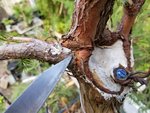SU2
Omono
In going-through the collection for fall-work I've done a ton of carving and this is often right-up-to living-veins, I do this to help roll-over however I've found such myriad "roll-over rates" or callousing-strength from various species that I just wish there were some index....Hence this thread!! 
I ask, *beg*(!), that anyone reading will add at least 1 item, it's fine if you're guesstimating it although please try and denote if you think it could be majorly off, but if everyone adds something I can keep editing this first post and include it all here
~~~~~~~~~~~~~~~~~~~~~~~~
[High/Medium/Low Callous-Profusion ratings, with 1-->10 guesstimates:]
Bougainvilleas: Low (2.5)
Crape Myrtle: High (7)
Grape Vines: Medium (4)
Ficus: High (9)
Bald Cypress: High (10.0 lol)
Maple: High (8-->9)
Oak: Medium (5) (quercus virginiana Oaks)
~~~~~~~~~~~~~~~~~~~~~~~~
Thanks a ton for any contributions to this list, I think that callousing-strength is a *very* massively-useful feature of a species when you're developing a tree, hell on my BC's the wound-response is so strong that I'll actually inflict wounds on the trunking in spots where I want a lil bulging (literally as simple as "cut a stripe now, get a raised-line in 3-->5 months" with BC's!), but for closing chop-wounds - which is the name of the game in early-development stock - this ^ callous-rating totally separates trees, would love to have a list going here (wonder where Podocarpus is on it...sadly I get the feeling they aren't that strong 'callousers')
I ask, *beg*(!), that anyone reading will add at least 1 item, it's fine if you're guesstimating it although please try and denote if you think it could be majorly off, but if everyone adds something I can keep editing this first post and include it all here
~~~~~~~~~~~~~~~~~~~~~~~~
[High/Medium/Low Callous-Profusion ratings, with 1-->10 guesstimates:]
Bougainvilleas: Low (2.5)
Crape Myrtle: High (7)
Grape Vines: Medium (4)
Ficus: High (9)
Bald Cypress: High (10.0 lol)
Maple: High (8-->9)
Oak: Medium (5) (quercus virginiana Oaks)
~~~~~~~~~~~~~~~~~~~~~~~~
Thanks a ton for any contributions to this list, I think that callousing-strength is a *very* massively-useful feature of a species when you're developing a tree, hell on my BC's the wound-response is so strong that I'll actually inflict wounds on the trunking in spots where I want a lil bulging (literally as simple as "cut a stripe now, get a raised-line in 3-->5 months" with BC's!), but for closing chop-wounds - which is the name of the game in early-development stock - this ^ callous-rating totally separates trees, would love to have a list going here (wonder where Podocarpus is on it...sadly I get the feeling they aren't that strong 'callousers')




